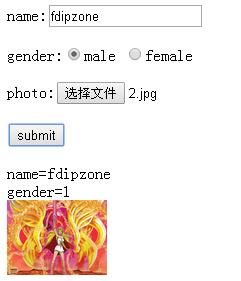 Backend Development
Backend Development
 PHP Tutorial
PHP Tutorial
 PHP combined with html5 uses FormData object FormData object and uploads images
PHP combined with html5 uses FormData object FormData object and uploads images
PHP combined with html5 uses FormData object FormData object and uploads images
FormData object can combine the name and value of all form elements in the form into a queryString and submit it to the background. When submitting using Ajax, using the FormData object can reduce the workload of splicing queryString.
Use FormData object
1. Create an empty FormData object, and then use the append method to add key/value
var formdata = new FormData(); formdata.append('name','fdipzone'); formdata.append('gender','male');
2. Get the form object and pass it into the FormData object as a parameter
<form name="form1" id="form1"> <input type="text" name="name" value="fdipzone"> <input type="text" name="gender" value="male"> </form> var form = document.getElementById('form1'); var formdata = new FormData(form);
Use FormData to submit the form and upload files:
<!DOCTYPE HTML PUBLIC "-//W3C//DTD HTML 4.0 Transitional//EN">
<html>
<head>
<meta http-equiv="content-type" content="text/html; charset=utf-8">
<title> FormData Demo </title>
<script src="//code.jquery.com/jquery-1.11.0.min.js"></script>
<script type="text/javascript">
<!--
function fsubmit(){
var data = new FormData($('#form1')[0]);
$.ajax({
url: 'server.php',
type: 'POST',
data: data,
dataType: 'JSON',
cache: false,
processData: false,
contentType: false
}).done(function(ret){
if(ret['isSuccess']){
var result = '';
result += 'name=' + ret['name'] + '<br>';
result += 'gender=' + ret['gender'] + '<br>';
result += '<img src="/static/imghw/default1.png" data-src="' + ret['photo'] + '" class="lazy" style="max-width:90%" alt="PHP combined with html5 uses FormData object FormData object and uploads images" >';
$('#result').html(result);
}else{
alert('提交失敗');
}
});
return false;
}
-->
</script>
</head>
<body>
<form name="form1" id="form1">
<p>name:<input type="text" name="name" ></p>
<p>gender:<input type="radio" name="gender" value="1">male <input type="radio" name="gender" value="2">female</p>
<p>photo:<input type="file" name="photo" id="photo"></p>
<p><input type="button" name="b1" value="submit" onclick="fsubmit()"></p>
</form>
<div id="result"></div>
</body>
</html>server.php
<?php
$name = isset($_POST['name'])? $_POST['name'] : '';
$gender = isset($_POST['gender'])? $_POST['gender'] : '';
$filename = time().substr($_FILES['photo']['name'], strrpos($_FILES['photo']['name'],'.'));
$response = array();
if(move_uploaded_file($_FILES['photo']['tmp_name'], $filename)){
$response['isSuccess'] = true;
$response['name'] = $name;
$response['gender'] = $gender;
$response['photo'] = $filename;
}else{
$response['isSuccess'] = false;
}
echo json_encode($response);
?>

Hot AI Tools

Undresser.AI Undress
AI-powered app for creating realistic nude photos

AI Clothes Remover
Online AI tool for removing clothes from photos.

Undress AI Tool
Undress images for free

Clothoff.io
AI clothes remover

AI Hentai Generator
Generate AI Hentai for free.

Hot Article

Hot Tools

Notepad++7.3.1
Easy-to-use and free code editor

SublimeText3 Chinese version
Chinese version, very easy to use

Zend Studio 13.0.1
Powerful PHP integrated development environment

Dreamweaver CS6
Visual web development tools

SublimeText3 Mac version
God-level code editing software (SublimeText3)

Hot Topics
 CakePHP Project Configuration
Sep 10, 2024 pm 05:25 PM
CakePHP Project Configuration
Sep 10, 2024 pm 05:25 PM
In this chapter, we will understand the Environment Variables, General Configuration, Database Configuration and Email Configuration in CakePHP.
 PHP 8.4 Installation and Upgrade guide for Ubuntu and Debian
Dec 24, 2024 pm 04:42 PM
PHP 8.4 Installation and Upgrade guide for Ubuntu and Debian
Dec 24, 2024 pm 04:42 PM
PHP 8.4 brings several new features, security improvements, and performance improvements with healthy amounts of feature deprecations and removals. This guide explains how to install PHP 8.4 or upgrade to PHP 8.4 on Ubuntu, Debian, or their derivati
 CakePHP Date and Time
Sep 10, 2024 pm 05:27 PM
CakePHP Date and Time
Sep 10, 2024 pm 05:27 PM
To work with date and time in cakephp4, we are going to make use of the available FrozenTime class.
 CakePHP File upload
Sep 10, 2024 pm 05:27 PM
CakePHP File upload
Sep 10, 2024 pm 05:27 PM
To work on file upload we are going to use the form helper. Here, is an example for file upload.
 CakePHP Routing
Sep 10, 2024 pm 05:25 PM
CakePHP Routing
Sep 10, 2024 pm 05:25 PM
In this chapter, we are going to learn the following topics related to routing ?
 Discuss CakePHP
Sep 10, 2024 pm 05:28 PM
Discuss CakePHP
Sep 10, 2024 pm 05:28 PM
CakePHP is an open-source framework for PHP. It is intended to make developing, deploying and maintaining applications much easier. CakePHP is based on a MVC-like architecture that is both powerful and easy to grasp. Models, Views, and Controllers gu
 CakePHP Creating Validators
Sep 10, 2024 pm 05:26 PM
CakePHP Creating Validators
Sep 10, 2024 pm 05:26 PM
Validator can be created by adding the following two lines in the controller.
 How To Set Up Visual Studio Code (VS Code) for PHP Development
Dec 20, 2024 am 11:31 AM
How To Set Up Visual Studio Code (VS Code) for PHP Development
Dec 20, 2024 am 11:31 AM
Visual Studio Code, also known as VS Code, is a free source code editor — or integrated development environment (IDE) — available for all major operating systems. With a large collection of extensions for many programming languages, VS Code can be c





